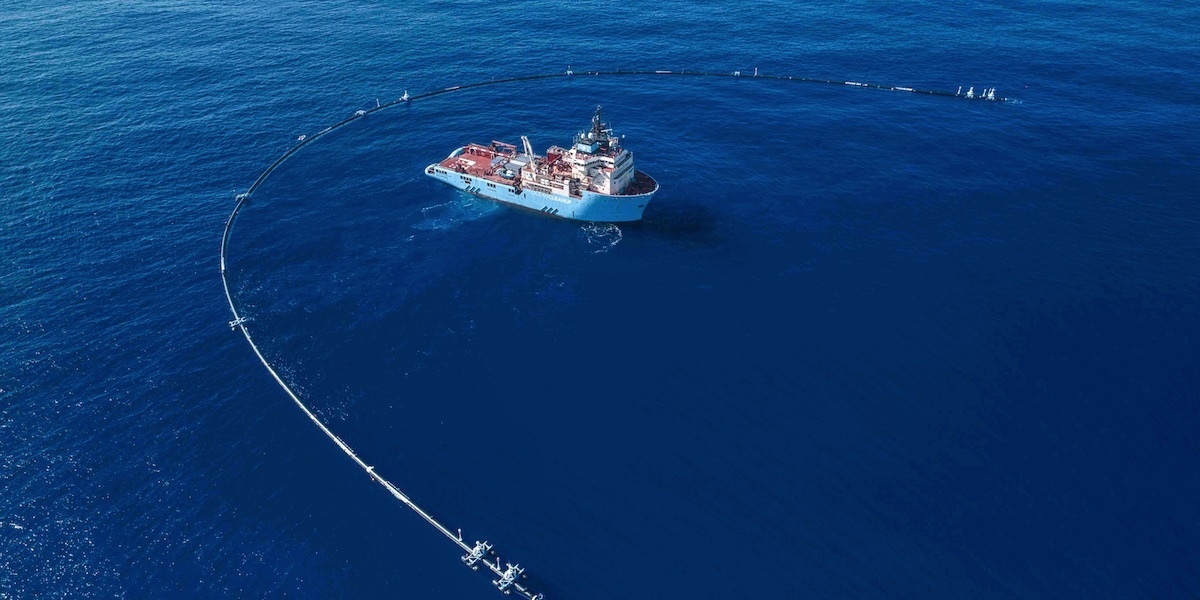

Installation of System 001 at Pacific Trial test site on Sept. 15. The Ocean Cleanup
Months after its highly anticipated deployment off the San Francisco coast, Boyan Slat’s multimillion-dollar Ocean Cleanup system is not cleaning up any plastic.
“System 001″—which consists of a 600-meter-long floating pipe with a tapered 3-meter skirt attached underneath designed to catch debris—”is attracting and concentrating plastic, but not yet retaining it,” the organization admitted Tuesday.
The #OceanCleanup Readies Historic Launch But Challenges Lie Ahead https://t.co/UVFj8sYxFD @ShaunFrankson @5gyres @savingoceans
— EcoWatch (@EcoWatch) September 8, 2018
Slat explained that System 001, which has been in the Great Pacific Garbage Patch since October, might be traveling too slow to retain the plastic.
“Sometimes the system actually moves slightly slower than the plastic, which of course you don’t want because then you have a chance of losing the plastic again,” the 24-year-old Ocean Cleanup founder and CEO said to the AP.
Engineers are now working out how to increase the speed of the device. Despite the setback, Slat remains hopeful.
“What we’re trying to do has never been done before. So, of course we were expecting to still need to fix a few things before it becomes fully operational,” he told the AP.
Just a reminder for media (and critics) who enjoy writing that “The Ocean Cleanup doesn’t work”: most aspects of concept have been confirmed (wind vaning, intercepting plastic, wave following) – it’s just not moving fast enough yet. This is fixable.
— Boyan Slat (@BoyanSlat) December 11, 2018
The team’s main goal is to remove 50 percent of the garbage patch within 5 years.
Slat shot to fame more than five years ago with his moonshot idea to clean up our plastic-filled seas. His plan inspired people around the world, and more than $40 million was raised ahead System 001’s launch this summer, Wired reported.
The money went to years of research, development and prototyping. The team also conducted an aerial survey to map the Great Pacific Garbage Patch, which counted an estimated 1.8 trillion pieces of plastic weighing 80,000 metric tons, the equivalent of 500 Jumbo Jets, currently afloat in the area.
Still, experts and other critics have consistently expressed doubts about the Ocean Cleanup concept. As EcoWatch previously mentioned, there’s the fear that the system could harm fish or other bycatch. Also, the idea of a “patch” of garbage where debris floats on the surface of the water is a myth—plastics are found across the seafloor and vertically throughout the ocean.
Others have suggested that upstream designs (i.e. Baltimore Harbor’s solar-powered trash wheel) and policy solutions such as bans on straws, grocery bags and other single-use products will better stem the flow of plastics before it reaches sea.
On Sunday’s CBS’ 60 Minutes, Denise Hardesty, a scientist with CSIRO’s Oceans and Atmosphere, said she’d “love to be wrong” about the Ocean Cleanup, but she advised it’s much smarter to place trash booms near city centers or install rubbish traps at rivers that feed out into the mouth of the ocean.
“You know, I think the analogy that you hear often is, ‘If you’ve got a flood in the bathtub you’re not gonna go just get a bunch of towels and try to keep cleaning it up, because it’s still flooding over. You really need to turn off the tap, right?'” Hardesty told 60 Minutes correspondent Sharyn Alfonsi.
Alfonsi later asked Slat to respond to the skeptics.
He replied, “I think humanity can do more than one thing at the same time. And—you know—if your bathroom is over-flooding, I’m still pretty happy that the mop exists. Eventually we need to mop it up, right?”
- 22-Year-Old Raises $21.7 Million to Rid Pacific Ocean of Plastic
- The Ocean Cleanup Readies Historic Launch But Challenges Lie ...

 233k
233k  41k
41k  Subscribe
Subscribe 